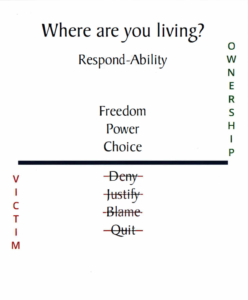
Living above the line is related to the Key of Ownership, one of our 8 Keys of Excellence principles to live by. Life’s challenges come at us from all directions. At home, at school, and with friends, challenges are what keep life interesting. As these challenges arise, we have choices in how to approach them. No matter how we choose to respond, our choices come from one of two places: above the line or below the line.
The line, which sits constantly on the horizon of our character, represents responsibility. Living above the line is a powerful life skill, a foundation for communication and personal interaction that highlights and puts into practice the concept of ownership, taking responsibility for our actions.
Living Above the Line is a Choice
Every one of us has a choice. We can choose to live either above the line or below the line. When we choose to live below the line, our lives become driven by circumstances. We are victims! We forgo ownership and send the message to the world that we are not in control of our lives. People who live below the line—choosing responses such as laying blame, justifying, denying, and quitting—are all showing the world that they struggle with personal responsibility.
Blame: Laying blame could quite possibly be the most common and damaging way to live below the line. To a student being called out by their parents for a low mark on a test, this could sound like “The teacher didn’t cover everything that was on the test! It’s not my fault!” While the student may think they’ve given their parents a viable excuse, it doesn’t change the test outcome (and the real reason for it) or promote responsibility, and it certainly doesn’t contribute to positive communication with their parents.
Justify: Another example of living below the line is justifying. Justification happens when we create reasons why we didn’t perform as we should have, reasons that avoid taking responsibility. “Everyone else was talking too!” This below-the-line response tries to provide reasons for failure, believing that the reason or excuse will make everything okay.
Deny: Denying is another below-the-line choice. “I wasn’t talking” doesn’t make the problem go away. This obviously ineffective response can cause others a lot of frustration, and make us seem unreliable or even dishonest.
Quit: Finally, the most disheartening form of below-the-line response is quitting. When we believe so strongly that we’ll fail that we don’t even bother to try, we sabotage our chances for success even before we’ve begun. Although this kind of negative thinking may give us an escape route for our possible failure, we deceive and diminish ourselves when we respond this way.
Living Above the Line is All About Respond-ability
When we live above the line, however, we are choosing responsibility and ownership. We don’t simply let things happen to us and justify, blame, or deny them. We make things happen for us. We have greater control because we stop blaming things outside ourselves for our current situation.
Living above the line means being accountable for our words and actions. It means looking at our options and finding ways to become more honest and sincere—with ourselves and with others. This above-the-line thinking leads to greater freedom as we take responsibility for all our actions—we take responsibility for our life. The choice is always ours.
